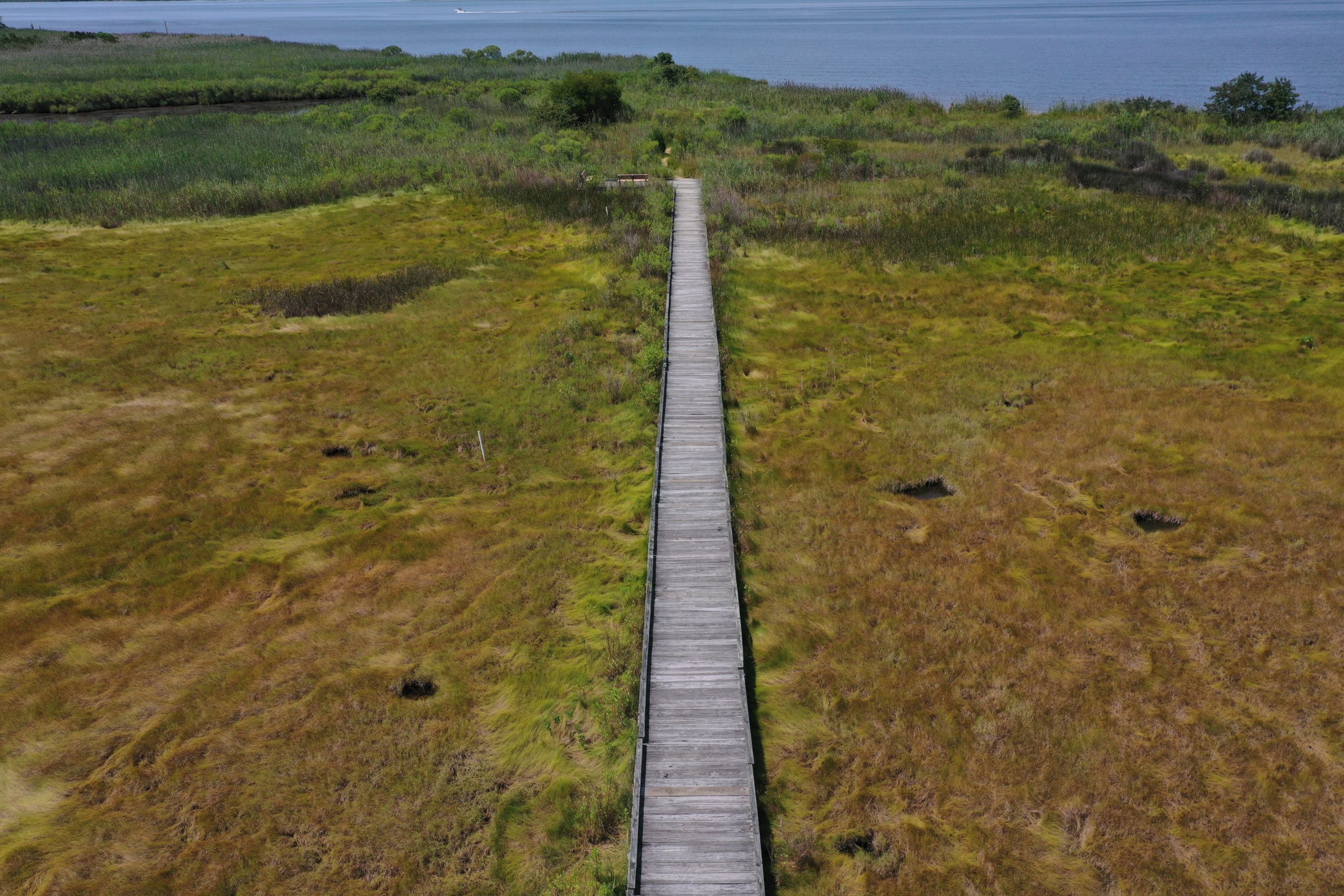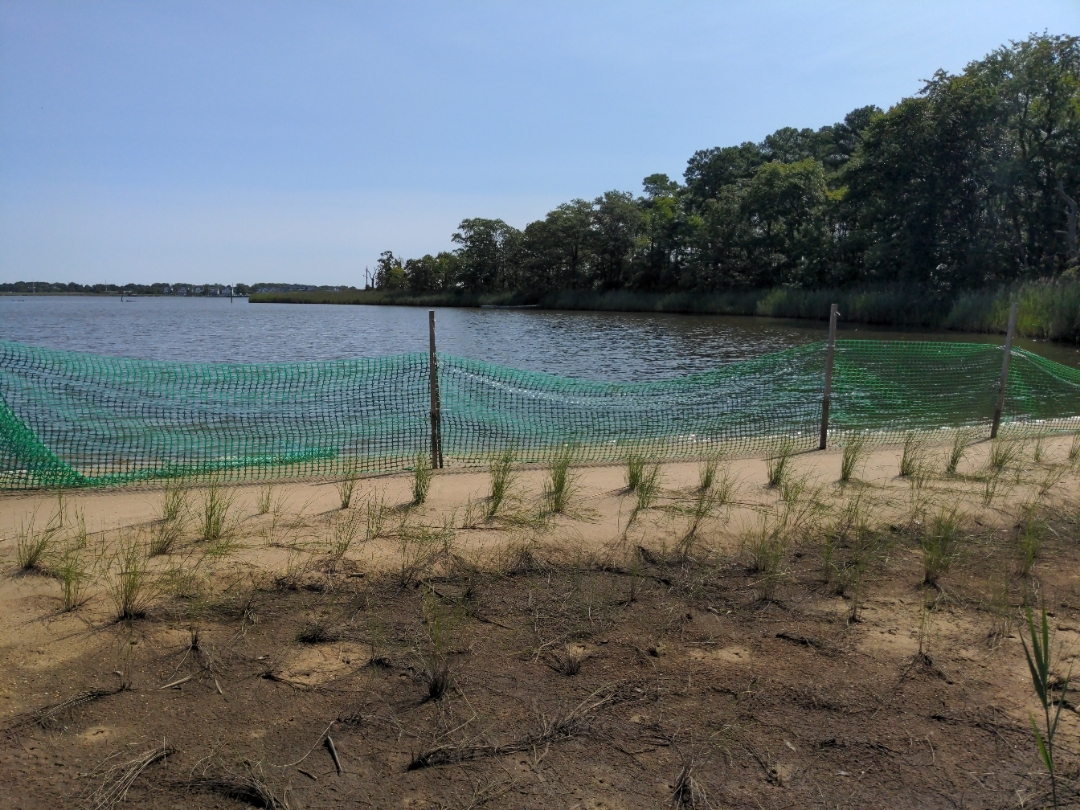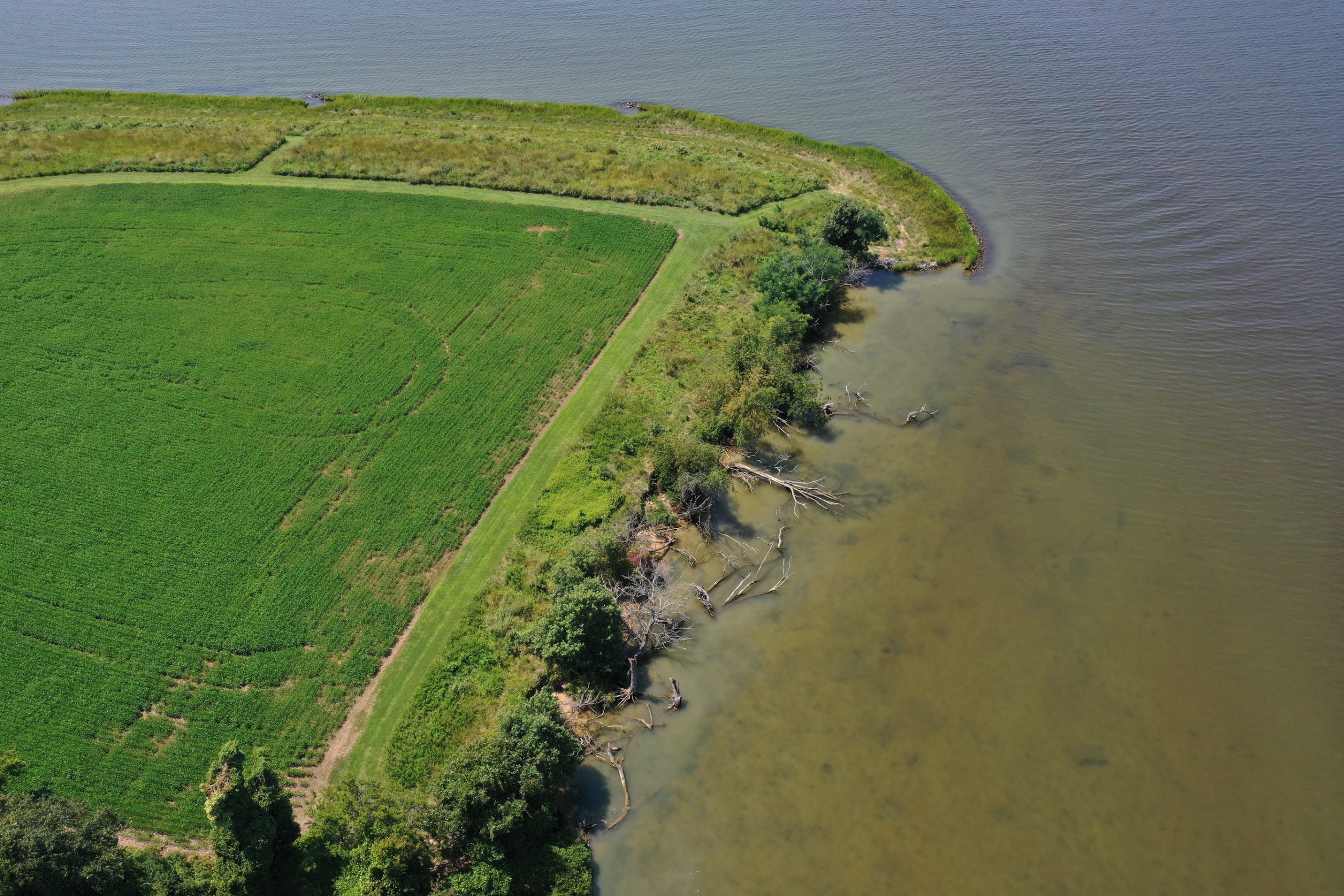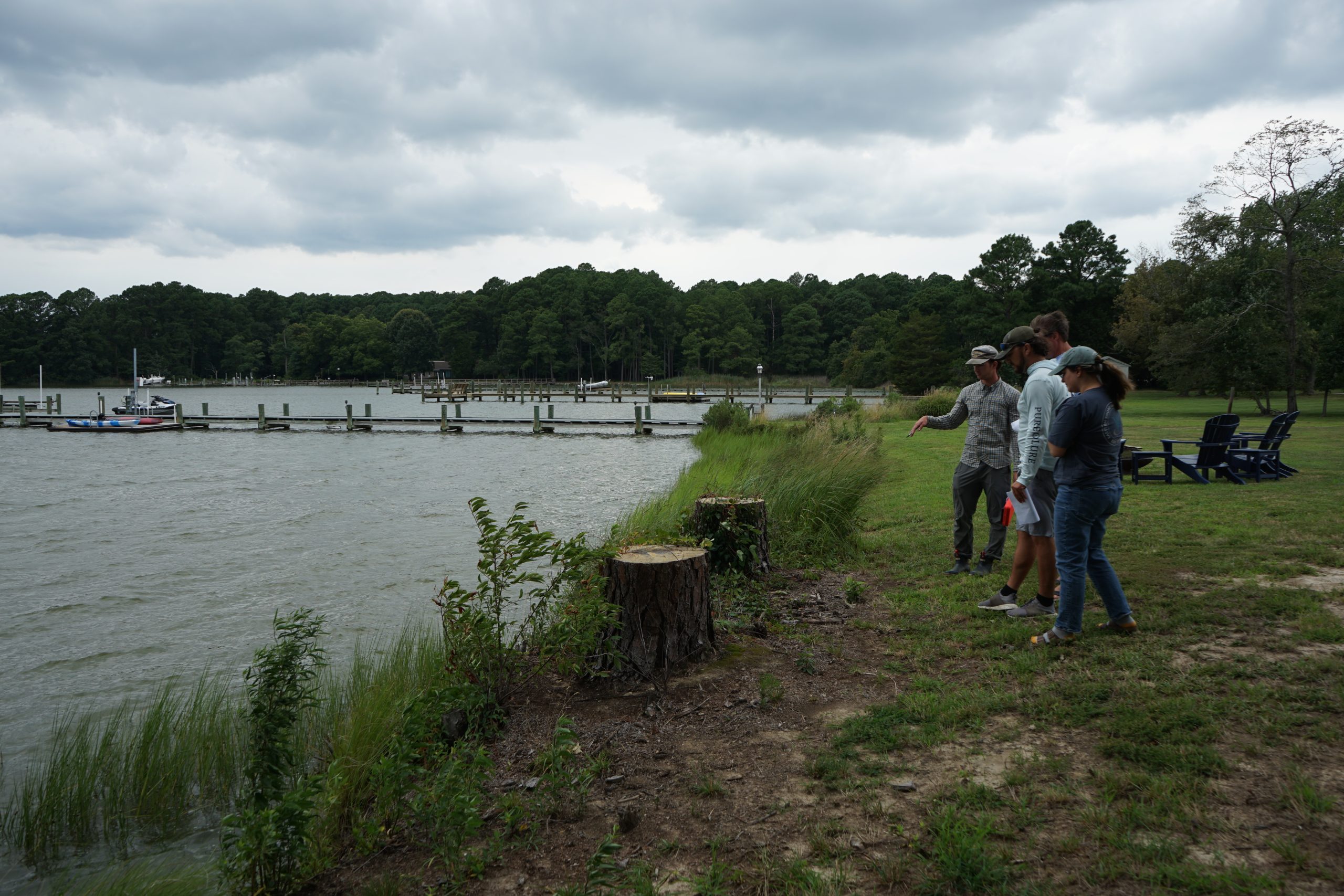Why Everybody Needs Living Shorelines

A boardwalk at Chesapeake Bay Environmental Center in Grasonville, Maryland. Image: Larisa Prezioso
On a recent kayaking trip in the Chester River, I began to notice two recurring types of shoreline: turf grass lawns leading up to the water’s edge and borders of tall, mature trees with the river lapping right at their roots. As I paddled closer, I also noticed how many of the riverbanks were littered with occasional skeletons of fallen trees. At first glance these riverside woodlands appeared beautiful, scenic, and even beneficial, considering their important ability to act as a filter between farm fields, developments, and the waterway. But this quick transition from trees to water is more precarious than it seems.
Originally, rivers and creeks across the Eastern Shore would transition from water to low marshes full of submerged aquatic vegetation, to salt meadows with taller marsh grasses, then tidal marshes, then native shrubs and vegetation before progressing into an upland area of taller plants and trees. Without these important transition areas between water and woodland, the shorelines are more vulnerable to strong currents and erosion. The trees that aren’t salt tolerant, like holly, hickory, spruce, and pine, are more likely to fail. This risks land loss, crop damage, water pollution, storm vulnerability, flood damage, and other increased negative effects of climate change. How is ESLC supposed to continue conserving land if the land we protect is slowly (and sometimes quickly) being erased? Every tide, every wave, washes away another inch of solid ground, another sweep of sediment.
Luckily, thanks to enhanced stewardship, there is a better way forward! Along with passionate and knowledgeable partners and colleagues, ESLC is committed to helping landowners attain the necessary resources for “living shoreline restoration,” a way of using native plants and ecological design to re-establish these missing transition zones so that soil can stay put. This type of restoration is not a direct requirement of most conservation easements, but it provides so many benefits (for the landowner, the land, and the community) that it has become a popular and sought-after enhanced form of stewardship.
Living shoreline restorations are, appropriately, tailored to a specific property’s scale and needs. And with many beautiful native plants to choose from, they can even be tailored to a person’s specific aesthetic, incorporating all sorts of plants from panicgrass to seaside goldenrod, beach plums, willows, and that beautiful marsh superstar spartina—a native grass that can dissipate wave energy by fifty percent! Projects can take a few years start to finish, sometimes longer if they require funding assistance. While some projects can be expensive and timely, ESLC can help landowners (whether their properties are conserved or not) to apply for grants from DNR, CBT, NOAA, NFWF and other sources. The good news is, once a project is finally in place, it should continue to grow and improve on its own, becoming more productive every year, a much better investment than riprap that needs regular maintenance, or bulkheads that need constant repair and can sometimes leach chemicals into the environment. If you are interested in learning more about living shoreline restoration for your property, please contact ESLC’s enhanced stewardship manager, Larisa Prezioso at LPrezioso@eslc.org or (908) 246-3419. Read on for some of our favorite ways that living shoreline restoration benefits us all.

Preserving Wildlife Habitat
Marshes, submerged grasslands, and oyster reefs that make up living shorelines provide habitat for some of the Eastern Shore’s most iconic wildlife! If you love oysters in the winter and crab feasts in the summer, then you probably love a living shoreline. Blue crabs, shellfish, terrapins, horseshoe crabs, herons, bitterns, muskrat, and rockfish, all depend on marsh habitat for survival. Chesapeake Bay Environmental Center, an ESLC easement in Grasonville, has invested in living shoreline restoration for decades, using groins, oyster balls, and native grass plantings to restore their Prospect Bay shoreline back to the healthier state it was in in the 1930s. The restored shorelines have helped to slow down wave energy, allow grasses and SAV to establish, and provide a safe haven for wildlife to nest, rest, and eat. But these resulting calm marshlands and pocket beaches are also a safe haven for people! Restoring these habitats gives families, students, and visitors more opportunities to observe wildlife which ultimately raises appreciation and awareness of the Eastern Shore’s unique and beautiful ecosystem. Preventing erosion and keeping ground stable is also essential as CBEC works towards making their facility more accessible to people of all abilities. CBEC is open to the public every day of the week and is worth a visit any of time of year.

An aerial shot of Wye Farm's farm fields and protected and unprotected shorelines. Image: Larisa Prezioso
Purifying Water and Reducing Farmland Erosion
Living shorelines are critical when it comes to filtering pollutants from water and improving water quality. Without plants “in the way,” excess nitrogen and phosphorous would flood right from the land into the waterway. The roots of marsh grasses and SAVs perform a crucial task of drinking up these excess nutrients as they enter the water. This is especially important on the Eastern Shore’s hundreds and hundreds of working waterfront farms. At the 311-acre Wye Farm easement in Talbot County, protected by ESLC since 1998, almost three miles of vegetated buffers protect the space between grain fields and Lloyd Creek, Broad Creek, Wye River, and Shaw Bay. A small, successful living shoreline restoration project installed by Environmental Concern is thriving in one corner of the property. But without transitional areas of spartina and marsh along the entire bank, most of this buffered shoreline will continue to shrink every season due to erosion and sea level rise. The current buffer of trees and shrubs will eventually cease to exist, allowing salty water to infringe on cropland, removing any filter for excess nutrients, contributing to pollution in the Miles River, and potentially threatening the historic buildings on-site that were once a childhood home of Frederick Douglass. ESLC’s enhanced stewardship manager, Larisa Prezioso, is currently working with the Tilghman family, Maryland DNR, and Underwood & Associates to develop and implement a living shoreline restoration plan for the farm which will ensure the future protection of working farmland, preserve Eastern Shore history, improve pollination for the farm’s crops (marsh bugs are terrific pollinators!), and also keep the water clean for future generations of fishermen, swimmers, and boaters.

Carbon Sequestration & Storm Surge Protection
Unlike hardened shorelines like seawalls and bulkheads, living shorelines have the ability to store carbon underground for centuries. Less carbon in the atmosphere reduces both the greenhouse gas effect and the negative effects of climate change, meaning numerous small living shoreline projects can have a substantial cumulative impact. Living shorelines are also champions when it comes to storm protection. Across the region, the rate and degree of erosion is increasing with climate change, partially due to sea level rise, and also due to increased intensity and frequency of storm events that increase erosive wave action. Thanks to their ability to reduce wave energy and hold down sediment, research has shown that living shorelines offer better protection from strong storms than hardened shorelines or shorelines with no protection at all. On the east coast, marshes have repeatedly outperformed manmade bulkheads during hurricanes.
ESLC is currently working with partners from Ecotone to establish two, connected living shoreline projects along Grace Creek in Talbot County. Protected via an ESLC conservation easement by the Train family in 1998, Grace Creek Farm is bordered by approximately 5,800 feet of shoreline along Grace Creek and 6,500 feet of shoreline along Leadenham Creek, both connected to the larger Choptank River. Certain areas of this extensive shoreline have been eroding at a rate of almost two feet per year, losing all that stored carbon, pushing sediments and nutrients into the waterways, digging too close to farm fields, and threatening the habitat of songbirds, marine life, and migratory waterfowl. The property manager and landowners of Grace Creek reached out to ESLC in order to assist with this concern, and now the project is underway with the addition of a neighboring property owned by the Resch family.
Thanks to funding provided by the Chesapeake Bay Trust Watershed Assistance Grant Program, Ecotone and ESLC are working together to design and permit a portion of the proposed shoreline restoration project. These projects will create approximately 4,885 linear feet of living shoreline, 2.8 acres of restored tidal marsh, and 1,925 linear feet of oyster reef habitat. In addition to that awesome carbon sequestration, these efforts are expected to reduce 232.33 pounds of nitrogen, 164.23 pounds of phosphorus, and 398 tons of sediment from entering the waterways of Grace Creek and Leadenham Creek per year. The new shorelines will also protect against future flooding and storms. ESLC’s easements are protected forever, an ideal location for living shoreline restorations which are proven to only become more and more effective as they age and mature. In the push to lessen climate change and sequester carbon, a living shoreline placed on a conserved property is a steadfast vote for the future of the Eastern Shore.






